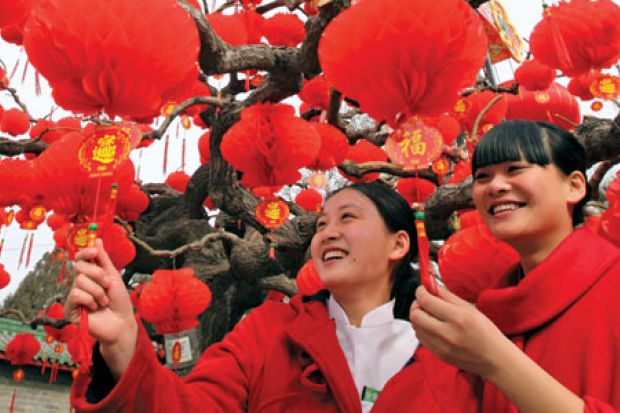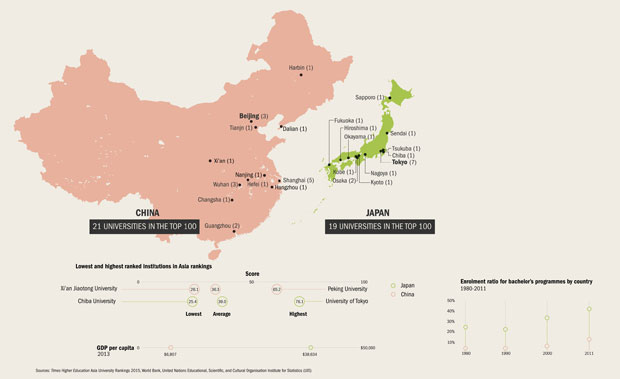China has overtaken Japan as Asia’s number one nation for world-class universities, according to the Times Higher Education Asia University Rankings 2015.
While the Land of the Rising Sun still boasts the rankings’ highest-placed institution, the University of Tokyo, it has lost ground overall, taking 19 of the top 100 positions, down from 20 last year. By contrast, mainland China has increased its presence in the prestigious league table, taking 21 places, up from 18 last year.
China’s special administrative region, Hong Kong, takes a further six spots.
“China has been very proactive and targeted,” says Alessia Lefébure. She is director of the Alliance (an academic joint venture between Columbia University, École Polytechnique, Sciences Po and Panthéon-Sorbonne University – Paris 1) and co-editor of the recently published Institute of International Education/American Institute For Foreign Study book, Asia: The Next Higher Education Superpower?
“For Japan, it’s a big frustration because it was the best and is still very strong, but it is not adapting as fast as China because China didn’t have any reputation or tradition to protect.
“The Chinese have implemented heavy funding and aggressive policies because they want to compete at the global level and are very ambitious. I am always impressed by how they have managed to bring universities such as Tsinghua and Peking to where they are.”
Tsinghua University breaks into the Asian top five for the first time, up from sixth. The top Chinese institution, Peking University (fourth), also climbs one place. The University of Hong Kong holds on to third, with the top five completed by the National University of Singapore (second).
Across the board, China has made significant progress. Sun Yat-sen University (42nd) secures a top 50 spot, rising 14 places, while Shanghai Jiao Tong University (39th) jumps eight places. The South China University of Technology (84th), the East China University of Science and Technology (joint 85th) and Huazhong University of Science and Technology (94th) all break into the top 100 for the first time.
In stark contrast, a number of Japanese representatives continue to slip – and in some cases plummet: Hokkaido University (63rd) was 48th in 2014; meanwhile, Osaka City University (joint 91st) drops 20 places this year.
Makoto Gonokami, the University of Tokyo’s newly appointed president, is aware of the pressures the country’s universities face to remain competitive. He says he will develop new academic disciplines and promote cooperation between the state, industry and academia to reverse Japan’s decline. Spurred on by government moves to allow university presidents more executive power and autonomy, Gonokami’s big plans for Tokyo involve creating a global base for international collaboration and attracting more overseas students.
“I want to make our institution a place where students and researchers can experience the excitement and joy imparted by knowledge gained, while conducting cutting-edge research,” he says. “I want this experience to give them the energy and intellectual nourishment to grow significantly.”
But Lefébure believes that Japanese institutions as a whole have relied too heavily on their existing reputations and have failed to attract as many international students and staff as they could have.
“The challenge for Japan is to maintain its excellence and its own domestic fuel for academic research,” she argues.
It has not been able to attract many foreign scholars or students so far, she adds, so it might be in “an urgent situation soon”. The lack of international academics is a serious problem, caused partly by the country’s inability to offer competitive salaries, Lefébure says.
This problem is not confined to Japan, either: Asia as a whole “cannot compete” with the job market in the West, she says, because academics who might otherwise be drawn to the continent are often put off, not just by uncompetitive salaries but also by high pollution levels and political instability.
Hong Kong’s “umbrella revolution” certainly grabbed the headlines last year, tensions blamed for the dip in Hong Kong’s performance in the THE World Reputation Rankings 2015. But in the Asia rankings it remains comfortably placed for now at least, with six top 100 players for the second year running.
The University of Hong Kong retains the overall bronze, followed by the Hong Kong University of Science and Technology (seventh, up from ninth in 2014).
Tony Chan, president of HKUST, which was established as recently as 1991, believes that the university’s blend of youth and dynamism, combined with talented staff and students, is the secret of its success.
“People are a major asset and a good reason behind HKUST’s quick ascendance on the global platform,” says Chan. “We have strived to attract the brightest minds from around the world: they form the backbone of our cutting-edge research breakthroughs, which have helped address many 21st-century challenges.
“We pursue excellence in research, but more importantly we also cultivate a community characterised by the traits of risk-taking, a willingness to overcome challenges, innovation and diversity.”
Meanwhile, the National University of Singapore, which retains the second spot for the third year running, and Nanyang Technological University, which rises one place to 10th, are also climbing the global rankings thanks to consistent government-level support.
Tan Chorh Chuan, president of the National University, says: “We and other higher education institutions in Singapore continue to enjoy the strong proactive support of the government, which has also launched a number of very important initiatives.”
Tan says that the government is now taking a two-pronged approach by fostering industry-academic collaboration and promoting sustainable graduate skills that are adaptable to changing technology.
“We will be intensifying our focus on ensuring that our graduates are future-ready by raising the translational impact of our research across the world and making our enterprise ecosystem one of the most vibrant in Asia,” he adds.
As a result of a strong education strategy driven by the state, Tan says that both collaboration and competition among Singapore’s universities are intensifying.
“I view competition and collaboration as positive things, since they provide the impetus to continually raise quality and standards, and reduce the risk of complacency,” he says.
South Korea’s top-ranked institutions remain relatively stable and the overall national picture is healthy. The country has two top 10 institutions: Seoul National University (down two places in sixth) and the Korea Advanced Institute of Science and Technology (KAIST) (eighth). It has 13 representatives overall, including the University of Seoul in joint 49th, which breaks into the top 50 for the first time after climbing 23 places.
Taiwan now has 11 institutions in the table (down two on last year). National Tsing Hua University (34th) has risen four places, but no other Taiwanese institution has improved its position: indeed, the majority have lost ground.
National Yang-Ming University (98th, down five places) is uncomfortably close to the drop, while Chung Yuan Christian University and Yuan Ze University dropped out altogether this year.
India, with its huge economic power and potential, promises much, but has yet to improve on its showing in the Asia rankings. It has nine players overall, one fewer than last year.
The Indian Institute of Science, the country’s new number one, enters the table in 37th (it is eligible for inclusion under the rankings methodology as it now accepts undergraduates). It pips Panjab University to the post (38th): a number of India’s institutes of technology follow in their wake.
“There are amazing things happening in India, but it’s all at grass-roots level, from private investments and initiatives, not from the government,” says Rajika Bhandari, deputy vice-president for research and evaluation at the Institute of International Education and co-editor of Asia: The Next Higher Education Superpower?
“It’s not clear to the world that India’s government is prepared to enter international competition the way China has decided to do,” she adds.
Exacerbating the problems, Indian universities at the lower end of the scale remain plagued by academic corruption and quality assurance issues, which both Bhandari and Lefébure argue will hold back the progression of the country’s academy “for some time”.
At the 10th convocation of Mizoram University in April, Shri Pranab Mukherjee, the president of India, said: “Though our higher education sector has rapidly expanded over the last few years, we have less to trumpet about the quality of our institutes. A university must strengthen its linkages with other academic institutes through faculty and student exchange, participation in seminars and workshops, collaborative research, and sharing of academic resources.”
This is an approach that has so far worked exceptionally well for China and other rising Asian stars.
Making strides
China has made significant progress and overtaken Japan as Asia's number one nation for world-class universities with 21 institutions in the top 100.
Register to continue
Why register?
- Registration is free and only takes a moment
- Once registered, you can read 3 articles a month
- Sign up for our newsletter
Subscribe
Or subscribe for unlimited access to:
- Unlimited access to news, views, insights & reviews
- Digital editions
- Digital access to THE’s university and college rankings analysis
Already registered or a current subscriber? Login

